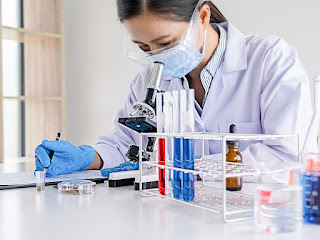Event 3: UNESCO’s Lighfest
Figure 1: Jaela Manuel at UNESCO's Lightfest
UNESCO’s Lighfest was an interesting experience especially as a chemistry major. Although chemistry is often associated with chemicals, a lot of the science behind reactions require light for the excitation of electrons. Certain light has wavelengths that determine its overall color and characteristics so this festival was a topic I could understand. Walter Gekelmen’s lecture on “Using lasers to map the motion of ions in a plasma physics experiment” focused on the science of photons getting excited by lasers which makes them detectable for X-rays was not only intriguing but beautiful see with its various colors on the screen for different ions. I found Dr. Gekelmen’s research to be similar to a research panel at UCLA where one of the presentations tracked diseases in mice with a dye that lit up on X-rays; unsurprisingly, it was the one I found most interesting with the color alone.
Figure 2: Tracking ions through lasers from Dr. Gekelmen's Using lasers to map the motion of ions in a plasma physics experiment”
The Lightfest also had an installation called “Fiat Lux” which combined science and art with its mixture of lasers, light and sound. The experience started in a dark room where calming music played and a bowl shooting a laser into the ceiling shaped as a circle. A video played in the background showcasing various parts of nature. However, with the given glasses, the experience heightened as the room’s colors suddenly tripled. It was if the blue, red, and green lasers that were once meshed into the one circle, split individually. The installation was a beautiful, calming experience that highlighted how science can enhance art. I would recommend Lightfest to my classmates to explore how light can be utilized for art and science.
1) LIGHTFEST Symposium at UCLA CNSI + ArtSci Fiat Lux Performance. us8.campaign-archive.com/?e=__test_email__&u=9baf6baeafa7dd6c42a6db349&id=5b54b156bb.
2) Gekelmen, Walter. “Using lasers to map the motion of ions in a plasma physics experiment”. BruinLearn DESMA 6. 18 April 2024
3) Keller P, Sowinska M, Tassetti V, Heisel F, Hajri A, Evrard S, Miehe JA, Marescaux J, Aprahamian M. Photodynamic imaging of a rat pancreatic cancer with pheophorbide a. Photochem Photobiol. 1996 Jun;63(6):860-7. doi: 10.1111/j.1751-1097.1996.tb09643.x. PMID: 8992507.

Comments
Post a Comment